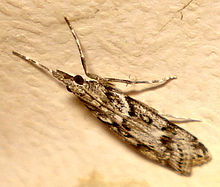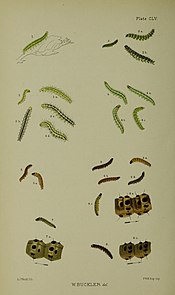Eudonia angustea is a moth of the family Crambidae described by John Curtis in 1827. It is found in southern and western Europe, the Canary Islands, Madeira and Turkey.[1]
| Eudonia angustea | |
|---|---|

| |
| Scientific classification | |
| Domain: | Eukaryota |
| Kingdom: | Animalia |
| Phylum: | Arthropoda |
| Class: | Insecta |
| Order: | Lepidoptera |
| Family: | Crambidae |
| Genus: | Eudonia |
| Species: | E. angustea
|
| Binomial name | |
| Eudonia angustea (J.Curtis, 1827)
| |
| Synonyms | |
| |
The wingspan is 17–22 mm.The forewings are narrow, whitish, mixed with brownish and sprinkled with black; base darker; lines whitish, dark-edged, first oblique, second sinuate; orbicular outlined with black; claviform black, touching first line; a black X-shaped discal mark, upper half filled with light brownish; subterminal line cloudy, whitish, hardly touching second. Hindwings are whitish-grey, terminally obscurely darker.The larva is blackish-grey, slightly greenish-tinged; spots darker or almost black; head pale brown; plate of 2 dark brown or almost black.[2][3]
Adults are on wing from July to late autumn.[4]

The larvae feed on mosses on walls and in sand dunes.
References
edit- ^ "Eudonia angustea (Curtis, 1827)". Fauna Europaea. Retrieved March 4, 2018.
- ^ Meyrick, E., 1895 A Handbook of British Lepidoptera MacMillan, London pdf This article incorporates text from this source, which is in the public domain. Keys and description
- ^ Mark Parsons, Sean Clancy, David Wilson A Guide to the Pyralid and Crambid Moths of Britain and Ireland: Atropos, England. ISBN:9780955108648
- ^ "63.069 BF1342 Eudonia angustea (Curtis, 1827). UKMoths. Retrieved March 4, 2018.
External links
edit